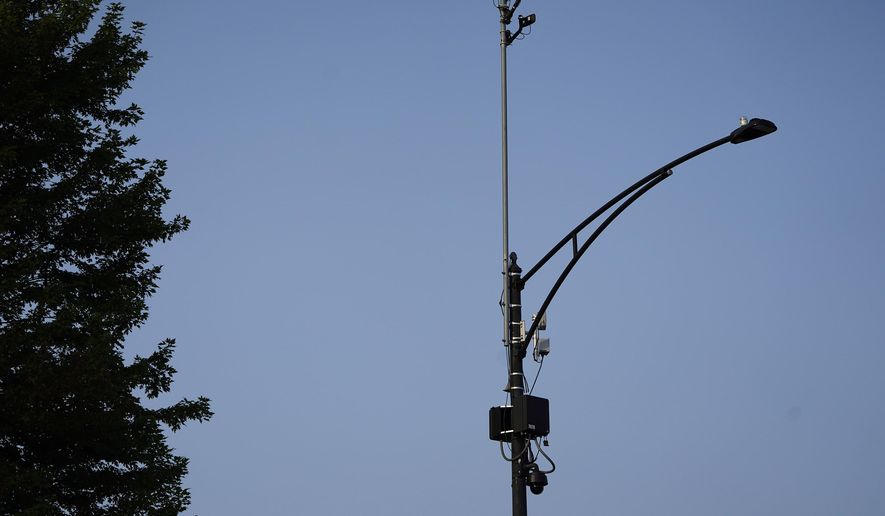A system of smart microphones that can identify the distinctive sound of a gun being fired and immediately notify the police was an idea that proponents hoped would make dangerous Chicago neighborhoods safer.
But critics say the artificial-intelligence-driven system that Chicago has spent millions installing is inaccurate, costs too much and often is used to unfairly target people of color.
ShotSpotter, a California-based technology firm that has installed gunshot-detection systems in 120 cities nationwide, including New York City, Boston, Baltimore and Chicago, is under fire from a group of skeptical local leaders in the Windy City.
Earlier this month, 16 Chicago aldermen called for public hearings into whether the city should pull out of a $33 million contract with ShotSpotter after an unflattering report out of the city’s inspector general’s office.
The August report found that “ShotSpotter alerts rarely produce evidence of a gun-related crime, rarely give rise to investigatory stops, and even less frequently lead to the recovery of gun crime-related evidence during an investigatory stop.”
The company’s acoustic sensors use an algorithm to flag noises of supposed gunfire, which are recorded by microphones and sent to a human “acoustic expert” who decides whether to classify it as a gunshot and alert police.
Police say the technology — which depends on microphones placed on buildings, telephone poles and street lamps and can cost up to $95,000 per square mile — helps agencies speed up crime scene response times and use resources more efficiently.
Chicago, with some of the nation’s highest rates of gun violence, is one of the company’s biggest customers and the police department says it is a “crucial” tool that “has detected hundreds of shootings that would have otherwise gone unreported.”
But the inspector general’s review of 50,176 alerts to the Chicago Police Department between January 2020 and May 2021 found that only 9.1% resulted in officers finding evidence of a gun-related crime.
Crime statistics for Chicago through Sunday showed shootings up slightly this year compared to the same time in 2020, going from 2,426 to 2,688. In 2020, the city of more than 2.7 million ended the year with 55% more shootings than in 2019, going from 2,598 to 4,033 — the most violence in the city since the mid-90s.
Deborah Witzburg, deputy inspector general for public safety, said she hopes the “analysis will equip stakeholders to make well-informed decisions about the ongoing use of ShotSpotter technology.”
Chicago’s multimillion-dollar contract with ShotSpotter began in 2018 and originally was supposed to expire earlier this month, but city officials extended the deal in December for another two years.
“If the department is to continue to invest in technology which sends CPD members into potentially dangerous situations with little information — and about which there are important community concerns — it should be able to demonstrate the benefit of its use in combatting violent crime,” Ms. Witzburg said.
A spokesperson for ShotSpotter, a Newark, California-based firm founded in 1996, defended the company’s products and services in an email statement.
“The [inspector general’s] report did not specifically suggest that ShotSpotter alerts are not indicative of actual gunfire whether or not a police report is filed or physical evidence is recovered,” the spokesperson said, adding that its accuracy “has been independently audited at 97% based on feedback from more than 120 customers.”
Jonathan Manes, an attorney with the MacArthur Justice Center at Northwestern University, said there is no “scientifically valid” study backing the accuracy claim — nor is there a study into whether ShotSpotter can “reliably” differentiate between gunshot sounds and other loud sounds like fireworks, construction noises and helicopters.
Mr. Manes led a study published by the university in May that drew similar conclusions to the inspector general’s report. After reviewing 46,743 alerts between July 2019 and April 2021, the authors found that only 11% led officers to evidence of a gun-related crime.
The ShotSpotter system, he said, “puts police on high alert and sends them racing into communities; but almost 9 times [out of] 10, the police don’t turn up evidence of gun crime or any crime at all.”
“It creates a powder keg situation for residents who just happen to be in the vicinity of a false alert,” Mr. Manes said. “At the same time, there is no evidence that the ShotSpotter system makes communities safer or reduces crime.”
A ShotSpotter spokesperson said the company commissioned data analytics firm Edgeworth Analytics to analyze the university study and it found those “conclusions were wrong, relying on deeply flawed analyses of incomplete data.”
The university study also found that most of the hundreds of microphones placed within 12 police districts across 117-square miles of the city are in neighborhoods with predominantly Black and Hispanic residents.
Since 2007, the federal government has spent nearly $6.9 million on ShotSpotter and other gunshot detection systems through discretionary grants and earmarked funds, according to a Justice Department spokesperson.
⦁ This article is based in part on wire service reports.
• Emily Zantow can be reached at ezantow@washingtontimes.com.




Please read our comment policy before commenting.